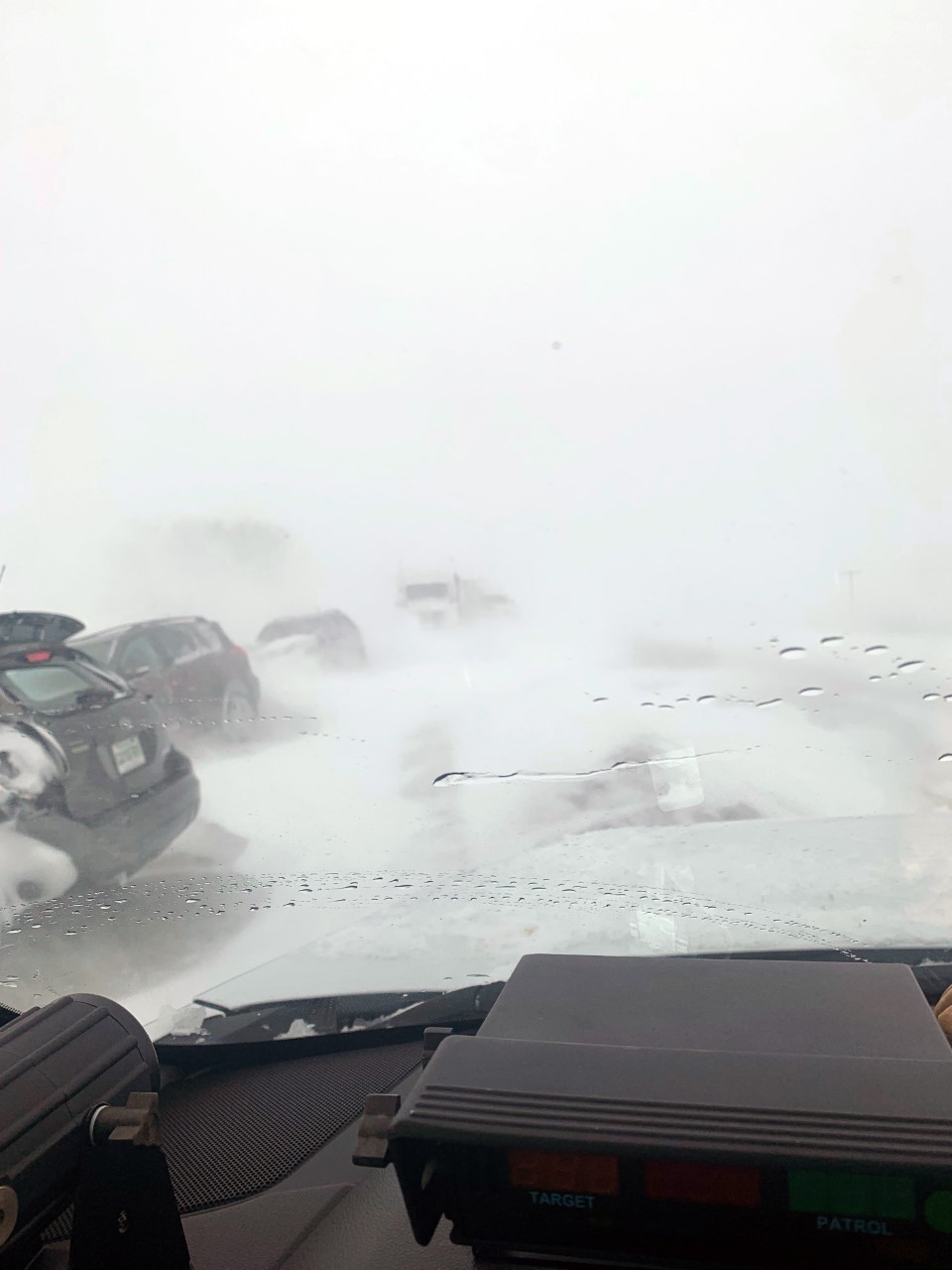Days after blizzard conditions hit Saskatchewan, the Saskatchewan RCMP is releasing details about its response and lessons for drivers.

The wintery weather hit the province from Tuesday to Wednesday, but Moose Jaw- and Regina-area roads were victim to a particularly “treacherous situation.”
An RCMP press release said a motor vehicle collision and highway closure on the eastbound lanes between the two cities created a backup of around 200 passenger vehicles and semis on Tuesday.
White Butte RCMP Const. Peter Rhead explained that blowing winds, upwards of 64 kilometres per hour, starting packing snow drifts around the stopped vehicles.
Rhead was one of the many officers responding at the scene on Tuesday.
“The vehicles that were at the front of the line experienced the worst of the weather. Some of them were stopped for multiple hours, so the snow drifts were pretty high around them,” he said in a news release.
Officers at the scene had to plan for both clearing the motor vehicle collision and making sure motorists stuck waiting on the highway were safe.
A collaborative effort between White Butte RCMP, Moose Jaw RCMP and Moose Jaw and Regina Combined Traffic Services Saskatchewan (CTSS) helped block access to the highway in a timely manner so tow trucks could safely make their way to the scene and clear the vehicles involved in the collision.
Officers were also checking on those stuck in their vehicles. The detachment started getting calls from people in the lineup wondering how long it was going to take for traffic to clear, as well as a few worried calls from people low on gas, some with kids in the car, Rhead said.
“We were prepared to bring fuel to vehicles if it was required, and to do whatever it took to make sure anyone in them was safe and comfortable,” said Rhead.
“That included being prepared to potentially remove people from their vehicles – if that need was identified.”

RCMP say by then, officers were faced with a five-kilometre-long line of vehicles and whiteout conditions. The detachment reached out to the RCMP’s search and rescue team, which was prepared with snowmobiles the moment they were needed.
The South District management team (SDMT) and White Butte detachment co-ordinator Staff Sgt. Jason Sauve were monitoring the situation overall in addition to other calls for service coming in to southern Saskatchewan.
“The RCMP Search and Rescue Team (SAR) was being considered based on a careful risk assessment of the storm continuing longer than anticipated and the concern of not being able to immediately bring in heavy equipment because of the weather,” said Sauve.
“SDMT was contacted to help us ready SAR with snowmobiles and toboggans in the event motorists required additional fuel, food or water, or had to be evacuated due to medical reasons.”
Fortunately, all of the resources were not required to be deployed.
By 3 p.m. that Tuesday, first responders managed to clear the collision from the highway and get vehicles on their way.
Some vehicles in the ditch or heavily snowed in were left until it was safer for owners to remove them.
Officers checked to make sure no one was left in the abandoned vehicles and police tape was put on the cars to signal they had been thoroughly checked.
White Butte RCMP officers, along with a Ministry of Highway front end loader, helped some of the vehicles lightly blocked in by snow get back on the road again.
Sauve called the teamwork from officers and detachments “fantastic.”
“I made a call to the acting Moose Jaw RCMP Detachment Commander and explained that despite the road being closed, there were still some motorists venturing onto Highway #1. Some of their detachment officers went out with CTSS to block access points to Highway #1 until the situation was resolved,” Sauve said.
Sauve explained that an important consideration was preventing other emergency situations like another collision in near-zero visibility conditions.
“Additional White Butte Detachment officers were utilized to do scene assessment, potentially help transport members of the public to safe locations and provide much needed supplies to officers who did not leave the scene all day,” Sauve said.
Sauve was also grateful for the assistance of the Ministry of Highways and its equipment. He said he had no idea how long people and officers would have been out on the roadway without their help.
“The collaboration with our partners at the Ministry of Highways and tow truck drivers who responded speaks further to the level of teamwork that happened out there,” Sauve said.
The RCMP received no reports of injuries from the incident.
“It was a situation where we were prepared for the worst, but thankfully, the worst didn’t happen,” Rhead said.
RCMP say the incident serves as a good reminder for officers and drivers to be prepared.
“As the provincial police who serves rural Saskatchewan, where winter weather can be considered rather wild at times, the RCMP must be prepared and have resources ready to respond to evolving situations, the release stated.
Sauve reminded civilians to make sure their vehicle has lots of fuel, and have extra warm clothes, snacks, water and a snow shovel on hand before travelling in the winter weather.
It’s also a good idea for drivers to have traction mats, a tow rope or chain and a booster cable while travelling, as well as a spare phone charger.
RCMP warn residents not to leave their vehicle if they do end up stranded on the highway, as other drivers may not be able to see them in adverse conditions.
Drivers are also reminded to make sure their tailpipe is clear of ice and snow or carbon monoxide could potentially seep into the vehicle.




Comments